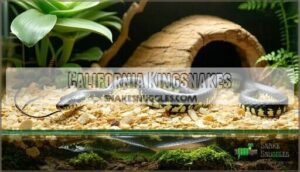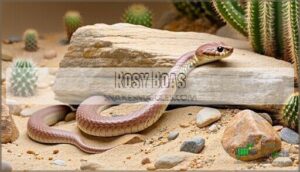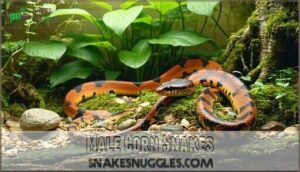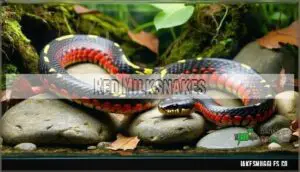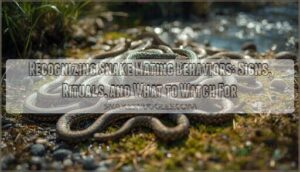This site is supported by our readers. We may earn a commission, at no cost to you, if you purchase through links.
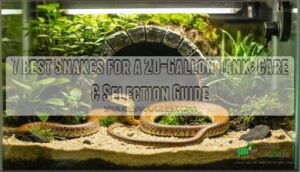 A 20-gallon tank sits empty in your room, waiting for its first resident. You’ve done the math, measured the space, and now comes the hard part: finding a snake that won’t outgrow it in six months.
A 20-gallon tank sits empty in your room, waiting for its first resident. You’ve done the math, measured the space, and now comes the hard part: finding a snake that won’t outgrow it in six months.
Unlike many reptiles that need massive enclosures as adults, several snake species thrive in this compact setup throughout their entire lives. The trick isn’t just about fitting a snake into the space—it’s about matching ground-dwelling species to horizontal dimensions and understanding how adult size determines long-term compatibility.
Kenyan sand boas barely reach 18 inches, while some corn snakes stretch past four feet, making species selection the difference between a lifelong home and a temporary stopover. The right match means your snake gets proper temperature zones, adequate movement, and the security it needs without you scrambling for a tank upgrade two years down the road.
Table Of Contents
- Key Takeaways
- What Snakes Can Live in a 20-Gallon Tank?
- Best Beginner Snakes for 20-Gallon Tanks
- Popular Snake Species for Small Tanks
- Care Requirements for 20-Gallon Snake Setups
- Choosing The Right Snake for Your Needs
- Frequently Asked Questions (FAQs)
- How often should I clean and disinfect the 20-gallon enclosure?
- What substrates work well for snakes in a 20-gallon tank?
- How can I make a 20-gallon enclosure more enriching and comfortable for my snake?
- Can two snakes share a 20-gallon tank?
- How often should I feed my snake?
- What lighting does a 20-gallon snake tank need?
- Do snakes in small tanks need climbing branches?
- When should I upgrade to a larger tank?
- Conclusion
Key Takeaways
- Adult size determines compatibility—snakes that stay under 2.5 feet (like Kenyan sand boas at 18-32 inches, Western hognose snakes at 14-24 inches, and most rosy boas at 24-36 inches) can live permanently in a 20-gallon tank, while species that grow beyond 3 feet will need upgrades within 18-24 months.
- Ground-dwelling species thrive in 20-gallon setups because the 30-inch horizontal length provides adequate space for thermoregulation and movement, whereas arboreal snakes require vertical space that this tank size can’t properly accommodate.
- Proper environmental setup requires secure lids, 3-4 inches of substrate for burrowers, and temperature gradients ranging from 85-90°F basking spots down to low-70s cool zones—with humidity levels varying significantly by species (30-40% for sand boas versus 65-75% for corn snakes).
- Cohabitation isn’t viable in 20-gallon tanks since approximately 70% of attempts result in stress-related health issues or aggression due to resource competition and territorial behavior, making individual housing essential for snake welfare.
What Snakes Can Live in a 20-Gallon Tank?
A 20-gallon tank can house several small snake species permanently, but choosing the right one depends on understanding how size and habitat needs match the enclosure’s dimensions. Not every snake marketed as "small" will thrive in this setup for life—some males stay manageable while females outgrow it, and ground-dwelling species have different space requirements than climbers.
Let’s look at the key factors that determine whether a snake is truly compatible with a 20-gallon tank.
Key Size and Habitat Considerations
When choosing a snake for your 20-gallon tank, you need to think about adult size first—snakes that grow beyond 2.5 feet will outgrow this enclosure. A standard 20-gallon long tank measures roughly 30 inches by 12 inches, which works best for terrestrial species that stay small.
You’ll also need to account for enrichment needs like hides, water bowls, and space for movement. Substrate depth matters too, especially for burrowing species, though shallow tanks limit layering to about 1-2 inches.
Temperature gradients are essential for digestion and health, so your setup must allow proper heating zones without cramping your snake’s ability to stretch out and explore comfortably. Remember that adequate enclosure size is vital for snake welfare.
Importance of Tank Dimensions for Snake Health
The floor space you provide directly shapes your snake’s ability to thermoregulate, move naturally, and maintain healthy stress levels. Tank dimensions impact your pet’s wellbeing in four key ways:
- Thermoregulation Needs – A 20-gallon tank’s 30-inch length lets snakes shuttle between warm and cool zones for proper digestion.
- Stress Reduction – Adequate enclosure size with multiple hides prevents cramped conditions that trigger defensive behaviors.
- Behavioral Enrichment – Horizontal space utilization aids natural movement patterns and exploration without growth restriction.
- Snake enclosure maintenance – Appropriate snake habitats allow proper cleaning access while maintaining temperature gradients.
Cramped conditions compromise immune function and feeding response over time.
Best Beginner Snakes for 20-Gallon Tanks
If you’re new to keeping snakes, you’ll want species that are forgiving, manageable, and won’t outgrow your setup. The following three snakes are excellent starter choices that thrive in a 20-gallon tank throughout their entire lives.
Each one brings something different to the table, so let’s look at what makes them stand out.
Kenyan Sand Boas
Burrowing Behavior defines these African natives, making them perfect beginner snakes for your 20-gallon tank. You’ll need at least 3 inches of substrate to let them tunnel comfortably. They stay manageable at 20–32 inches and show a Docile Temperament that’s ideal for interacting with them.
Humidity Needs run 60–80% for healthy shedding. It’s important to provide a proper temperature gradient to allow for thermoregulation.
Feeding Frequency is simple—appropriately sized mice every 7–10 days. Their Lifespan Potential reaches 15–30 years, so this enclosure size works for life.
Western Hognose Snakes
Western Hognose Snakes bring personality without demanding more space—adult males average 14–24 inches, fitting your 20-gallon tank for life. Their Defensive Displays are all show: they flatten and hiss but rarely bite.
You’ll want Substrate Depth of 3–6 inches, mixing soil and sand. Keep Humidity Levels around 30–50% to prevent respiratory trouble.
Enrichment Needs include:
- At least two secure hides for comfort
- Cork flats or plants for exploration
- Stable basking spot at 85–90°F
- Weekly water changes to guarantee hydration
Feeding Intervals are every 5–7 days with appropriately sized prey.
House Snakes
House snakes are nocturnal hunters that thrive in your 20-gallon tank—most individuals measure 24–30 inches as adults. Their Nocturnal Behavior means they’ll appreciate secure hides and low-stress lighting.
You’ll need Enclosure Security with tight-fitting locks to prevent escapes. Keep Basking Temperatures at 85–90°F with a 70°F cool side.
Humidity Levels stay around 40–60%, requiring spot cleaning to avoid scale rot. Feeding Frequency is every 7–10 days with thawed rodents.
Popular Snake Species for Small Tanks
Beyond the beginner-friendly options, several other small snake species have earned their place as favorites among keepers with a bit more experience. These snakes bring slightly different care requirements or temperaments but still thrive in a 20-gallon setup when you meet their needs.
Let’s look at four popular choices that work well in compact enclosures.
California Kingsnakes
California Kingsnakes make popular beginner snakes, though they outgrow a 20-gallon tank as adults. Juveniles up to 2 feet thrive in 20-gallon setups, but adult size reaches 3 to 4 feet—sometimes 5 feet—requiring a 40-gallon upgrade.
These nonvenomous snakes have ophiophagic tendencies, meaning they’ll eat other snakes, so solo housing is essential. Temperament variation exists, but most tolerate well with consistent interaction, making juvenile housing in smaller tanks manageable before the enclosure upgrade becomes necessary.
Rosy Boas
Rosy Boas rank among the best beginner snakes for permanent 20-gallon tank housing. Adult Size averages 24–36 inches depending on Locality Differences, with smaller specimens thriving their entire Lifespan Potential—up to 40 years—in this snake enclosure.
- Males usually stay under 30 inches, making a 20gallon tank sufficient for life
- Larger females may need 40-gallon upgrades as they mature
- Juveniles sometimes experience Feeding Issues in oversized enclosures
These docile, nonvenomous snakes move slowly and appreciate Enclosure Enrichment like hides and climbing branches.
Male Corn Snakes
Male Corn Snakes make popular pet snakes, but you’ll need to plan for growth. Juveniles up to 3 feet fit comfortably in a 20-gallon tank, yet Adult Size averages 3–4 feet—requiring 30- to 40-gallon upgrades.
Their curious Temperament and strong Escape Risks demand secure lids and plenty of Enclosure Enrichment like branches and hides.
Beginner Suitability is high for this snake species, though long-term enclosure planning is essential.
Red Milksnakes
Red Milksnakes captivate with stunning color morphs, yet juveniles under 2 feet fit a 20-gallon tank while adults averaging 24–36 inches need upgrades. Subspecies variations affect adult size considerably.
You’ll appreciate their docile temperament traits—they’re constrictors, not biters. Enclosure height should reach 18 inches for proper heating.
These pet snakes suit beginners willing to plan for long-term snake care requirements as tank size demands increase with growth.
Care Requirements for 20-Gallon Snake Setups
Setting up a proper 20-gallon tank isn’t complicated, but you need to get a few basics right to keep your snake healthy. Security, temperature control, and the right substrate make all the difference.
Here’s what every 20-gallon snake setup needs.
Enclosure Security and Lid Types
Snakes are escape artists by nature, so you’ll need a lid that locks securely or has clips to keep your pet safely inside. Screen lids work well because they provide proper ventilation while preventing escapes.
You can purchase commercial lids with locking mechanisms or create DIY options using weighted objects, but make sure there aren’t any gaps your snake can push through.
Substrate and Humidity Needs
Once the enclosure is secure, substrate depth and humidity monitoring become your next focus. You’ll want at least 3-4 inches of substrate to help control humidity and let burrowing species feel at home.
Species ranges matter here—Kenyan sand boas thrive at 30-40% humidity, while corn snakes need 65-75%. Shedding issues often pop up when humidity isn’t tracked with a digital hygrometer.
Bioactive benefits include consistent moisture retention and less frequent replacement, making reptile care simpler overall.
Heating and Temperature Gradients
Your snake’s body heat needs a proper runway, from a basking spot around 85-90°F down to a cooler zone in the low 70s. Heat sources like under-tank heaters or ceramic emitters work best when paired with thermostat control to prevent overheating. Temperature monitoring with digital thermometers at both ends confirms your gradient is dialed in.
- Basking spot: 85-90°F for digestion and thermoregulation
- Cool zone: Low 70s to let your snake self-regulate
- Heat sources: Under-tank pads or ceramic emitters with thermostat control
- Substrate depth: Affects heat retention in the vivarium floor
- Gradient importance: Prevents stress and promotes proper reptile care
Enclosure Cleaning and Maintenance
A clean tank isn’t just about looks—it’s about keeping bacterial buildup and waste from turning your snake’s home into a health hazard. Spot-clean waste daily, swap out soiled substrate weekly, and deep-clean the entire vivarium monthly with reptile-safe disinfectants.
| Task | Frequency | Focus Area |
|---|---|---|
| Waste Removal | Daily | Feces and uneaten prey |
| Substrate Replacement | Weekly (spot) / Monthly (full) | Soiled bedding zones |
| Disinfection Protocols | Monthly | Entire reptile enclosure surfaces |
Water bowls need scrubbing every few days to prevent mold and bacteria from taking hold in your reptile habitat.
Choosing The Right Snake for Your Needs
Finding the right snake isn’t just about what fits in your tank—it’s about matching a species to your lifestyle and comfort level. Consider how much you want to interact with your pet, what you’re willing to feed it, and how long you’re prepared to care for it.
Here’s what matters most when making your choice.
Activity Levels and Handling Temperament
If you’ve picked your perfect snake based on size and setup, the next big question is how much hands-on time you’re really up for—because some species are natural homebodies while others practically beg to explore beyond their glass walls.
Docile species like Kenyan sand boas and rosy boas show minimal activity patterns but tolerate occasional interaction well, making them beginner-friendly choices. Western hognose snakes prefer playing dead over biting, while house snakes adapt quickly to captive snake behavior with consistent interaction.
Temperament variations matter—wild-caught specimens need more patience than captive-bred ones.
Feeding and Dietary Preferences
Once you’ve sorted out temperament and interaction frequency, the next piece of the puzzle is what—and how often—your snake will actually eat.
Most small snakes in 20-gallon tanks thrive on appropriately sized prey like pinky or fuzzy mice every 5-10 days. California kingsnakes and rosy boas accept frozen-thawed rodents readily, while rough green snakes need specialized diets of insects. Garter snakes sometimes require nutritional supplements due to their unique feeding preferences.
Captive-bred specimens usually adapt faster to standard feeding schedules than wild-caught individuals.
Lifespan and Long-term Care Considerations
Before choosing your snake, think about the long haul—many species suitable for a 20-gallon tank can outlive a family dog.
- Lifespan Commitment: Corn snakes, California kingsnakes, and rosy boas often reach 20–30 years in captive settings, requiring decades of consistent care.
- Growth Stages: Juveniles may thrive in 20-gallon setups initially, but most outgrow them by 18–24 months, requiring enclosure upgrades.
- Enclosure Impact: Proper temperature gradients and regular cleaning directly reduce chronic risks like scale rot and respiratory infections.
- Veterinary Care: Annual wellness checks and prompt treatment for mites or shedding issues greatly improve snake lifespan.
Frequently Asked Questions (FAQs)
How often should I clean and disinfect the 20-gallon enclosure?
Your snake deserves consistency, cleanliness, and care. Spot-clean waste daily to prevent illness and bacteria buildup. Replace substrate every month or when soiled.
Deep clean and disinfect the enclosure quarterly using reptile-safe disinfectant types, ensuring proper snake care requirements throughout.
What substrates work well for snakes in a 20-gallon tank?
Your substrate choice depends on your snake’s burrowing needs and humidity levels. Aspen shavings work well for most species, but avoid aromatic shavings like cedar. Burrowing species need deeper substrate depth—at least three inches.
Paper-based beddings simplify cleaning frequency while maintaining proper reptile habitat setup requirements.
How can I make a 20-gallon enclosure more enriching and comfortable for my snake?
Your snake needs hiding spots, comfortable substrate for burrowing, and a proper thermal gradient with distinct hot and cool zones.
Add climbing opportunities if your species is active, and vary the enclosure layout to encourage natural snake behavior and exploration.
Can two snakes share a 20-gallon tank?
Nearly 70% of cohabitation attempts result in stress-related health issues or aggression. Don’t house two snakes together in a 20-gallon tank.
Species compatibility, resource competition, and territorial behavior create serious stress factors.
Ethical considerations demand separate enclosures for ideal snake habitat and individual well-being.
How often should I feed my snake?
Feeding frequency depends on your snake’s age and species needs. Younger snakes in captivity usually eat every five to seven days, while adults may only need prey every ten to fourteen days.
Monitor your snake’s body condition during the shedding cycle to avoid obesity risks.
What lighting does a 20-gallon snake tank need?
Looking for the right balance between day and night? Most snakes don’t need UVB lighting, but basking bulbs create essential heat gradients. Use 12-hour light cycles mimicking natural rhythms. Skip night lighting unless monitoring temperatures.
For planted enclosures supporting plant growth, low-level UVB benefits live foliage without stressing nocturnal species.
Do snakes in small tanks need climbing branches?
It depends on whether your snake is arboreal or terrestrial. Most species suitable for 20-gallon tanks—like Kenyan sand boas, hognose snakes, and rosy boas—are ground-dwellers that don’t need branches.
They prefer burrowing substrate over climbing enrichment options, utilizing horizontal space for exercise and thermoregulation instead.
When should I upgrade to a larger tank?
Most species we’ve discussed can stay put for life, but watch for signs your snake has outgrown its home. If your pet can’t fully stretch out or seems constantly restless, it’s time to upgrade.
Species variation matters—females often grow larger than males, requiring long-term planning for enrichment needs and behavioral changes as growth rate accelerates.
Conclusion
Picture a coiled ribbon resting perfectly in the palm of your hand—that’s the scale you’re working with. The snakes that thrive in a 20-gallon tank aren’t just small; they’re ground-dwellers built for horizontal movement, not vertical climbing.
Match your species to the space from day one. Kenyan sand boas, Western hognoses, and rosy boas don’t just survive in this setup—they flourish.
What snakes can live in a 20-gallon tank comes down to adult size, not promises of future upgrades. Choose wisely now, and you’ll skip the scramble later.
- https://www.youtube.com/watch?v=Dv-ulWculFY
- https://www.visionproducts.us/blog/reptiles-for-small-enclosures/
- https://community.morphmarket.com/t/extra-20g-tank-occupant/36659
- https://ned.apes.org.uk/books/general-reptile-care-and-rules/page/uk-guide-to-reptile-enclosure-sizes-general-rules-metrics-and-species-specific-recommendations
- https://static1.squarespace.com/static/6268f004e9da29777b080f8f/t/645aa4a4bce9de6feca4faab/1683661990992/FBH+Recommended+Minimum+Enclosure+Size.pdf


